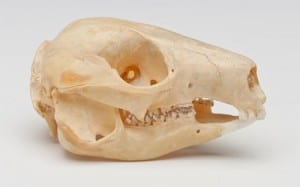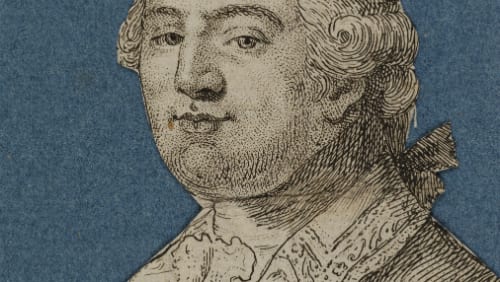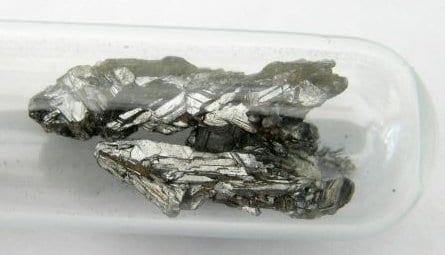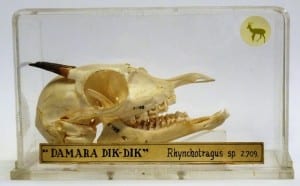Underwhelming Fossil Fish of the Month: January 2016
By Mark Carnall, on 29 January 2016
January 2016 was a big month for palaeontology in the media. This month you may have caught a programme on fossil Mesozoic vertebrate finds featuring one of the most beloved natural historians, some might go as far to say, ‘National Treasure’. No, I’m not talking about David Attenborough and some big dinosaur, that’s the easy route to media coverage. I’m talking about our very own underwhelming fossil fish on Radio 4’s Inside Science programme. If you’re new to this blog series, the humble goal is to increase global fossil fishteracy one underwhelming fossil fish from the Grant Museum collections at a time.
You might expect that with the boost in coverage, we’d have some timely underwhelming fossil fish merchandise to shill, a calendar perhaps or a pack of underwhelming fossil fish Top Trumps cards. However, as I’ve told numerous producers this week who tried to secure the underwhelming fossil fish of the month film rights, this is not the UFFotM way. We’re going to be ploughing on ahead with yet another uninteresting fossil fish, not one that’s any more or less underwhelming, just another un-noteworthy, comme ci, comme ça fossil. No fuss and especially no muss. Read the rest of this entry »
Safe drinking water in Mexico: a project by EWB-UCL
By Nick J Booth, on 28 January 2016
On Friday 5th February the student society Engineers Without Borders UCL will be hosting a special event in the Rock Room focusing on one of their successful projects. Between 12.30 – 4.30pm members of the society will be on hand to talk to visitors, who will also get the opportunity to inspect museum specimens from the Grant Museum, UCL Art Museum and UCL Geology Collections which relate to the subject of their project – providing safe drinking water to a rural community in Mexico whose drinking water was contaminated with fluoride and arsenic.
UCL Engineers Without Borders’ mission is to ‘facilitate human development through sharing engineering and technical expertise in the developing world’. It is open to everyone to join, not just those with an engineering background and in 2014-15 it was involved in nine development projects across the world.
I met the society’s president, Gabriela May Lagunes, last summer at UCL’s Spark Fest, Read the rest of this entry »
Specimen of the Week 224: The Rock Wallaby Skull
By Jack Ashby, on 25 January 2016

Rock wallaby skull. LDUCZ-Z845
The high octane pop-rock band The B52s are responsible for one of the world’s most aggressive earworms – Rock Lobster. A tune so catchy that it takes no heed of the taxonomic boundaries in which it was placed. The B52s were very clear that the song’s habitat is a beach, and the lobster was discovered when somebody looked under a dock in 1978. Nevertheless, whenever I am on fieldwork in Australia, the unforgettable (no matter how hard I try) chorus begs to be applied to every rock-dwelling lifeform I encounter, none of which are crustaceans. In the sandstone escarpments of northwest Australia there are plenty of zoological opportunities for the song to crop up: rock ringtail; rock pigeon; rock rat; rock monitor; rock dtella; rockhole frog; but most of all, this week’s Specimen of the Week…
Fluid Fish and Mystery Precipitate
By Emilia L Kingham, on 21 January 2016
Part of the work that we do as conservators for UCL’s Museums and Collections is to maintain the condition of the various collections. The Grant Museum of Zoology and Comparative Anatomy has approximately 300 fluid preserved specimens on display in the museum and 3500 fluid specimens in the stores.
A King as catapult practice!
By Jenny M Wedgbury, on 21 January 2016

Detail of Noel Lemire (1724 – 1801), After Jean Michel Moreau (1741 – 1814), Louis Seize, 1792, Coloured etching, Inscribed: Bonnet des Jacobins donné au Roi 20 Juin 1792 (The Jacobin bonnet of liberty given to the King 20 June 1792); A Paris Chez L’Auteur Rue des Augustins, UCL Art Museum
On this day, 21 January 1793, Louis XVI of France, stepped out of a carriage in the Place de la Révolution (formerly Place Louis XV) and climbed the steps to the guillotine.
Specimen of the Week 223: The Tasmanian wolf
By ucwepwv, on 18 January 2016
One of the most interesting things about zoology for me is the way in which skulls are sculpted by evolutionary and environmental forces. A particularly fascinating outcome of such processes is convergent evolution, which occurs when distantly related organisms live in a similar environment and have a similar mode of life, resulting in them looking and often behaving like each other. My favourite example of this phenomenon is shown by my Specimen of the Week…
Read the rest of this entry »
Revolution under a King: French Prints 1789-92
By Jenny M Wedgbury, on 15 January 2016

Detail from the light box outside UCL Art Museum of Jean-Michel Moreau after Noël Le Mire, Louis Seize: Bonnett des Jacobins Donne au roi, le 6 Juin 1792, Copper Engraving, UCL Art Museum
Our exhibition Revolution under a King opened with the start of term at UCL on Monday 11 January. The exhibition features a selection of prints from the early, highly volatile years of the French Revolution, curated by Emeritus Professor David Bindman and Dr Richard Taws, in collaboration between UCL Art Museum and UCL History of Art. Is already attracting visitor numbers that we have grown to be accustomed to since the Museum’s refurbishment – on average 80 visitors per day and on average visitors can be found spending between 30-45min in the museum. It has been wonderful working on this exhibition, as it really highlights the complexity of curatorial practice with researchers, which is highly collaborative and unites multiple, sometimes competing, agendas. I’m really pleased with the outcome.
The Robert Noel Collection of Life and Death Masks – what we know now.
By Nick J Booth, on 15 January 2016
The Robert Noel Collection of Life and Death Masks consists of 37 plaster casts made in Germany in the 19th Century. As the name suggests the plaster casts were taken of both the living and the dead, and were collected by Robert Noel (a distant relation of Ada Lovelace) to show the ‘truth’ of phrenology, which simply put was the study of the lumps and bumps in people skulls in the belief that this gave insight into a person’s character. In this blog I aim to tell the story of the collection (as we know it now) and gather links to the various blogs, videos, articles that are available online. Enjoy!
When I started working at UCL 4-ish years ago we knew almost nothing about the Robert Noel Collection of Life and Death Masks. In its life at UCL it had been on display in the Galton Eugenics Laboratory, the Slade School of Fine Art and (reportedly) at one point it’s been fished out of a skip. Now, thanks to the work of a number of UCL students, we know so much more – the names of the people represented in the collection, what Noel thought of them and the background to Noel himself. They have also been properly conserved and looked after, so they will survive for another 150 years or so. Read the rest of this entry »
New Year, New Resolutions: Museum Conservation Conversations on the UCL PACE Museums and Collections Blog!
By Susi Pancaldo, on 12 January 2016
The PACE Conservation Laboratory on UCL’s Bloomsbury Campus serves the needs of UCL’s diverse collections. The objects we have examined and treated in 2015 have ranged from fragile inorganic and organic archaeological materials, small sculpture and other works of art, dry- and fluid-preserved zoological specimens, all manner of scientific teaching models, an array of mechanical and electrical scientific instruments, and much, much more!!

Faience ‘shabti,’ during treatment: Petrie Museum of Egyptian Archaeology (UC20989); Bronze medal: UCL Art Museum (10026); Mammoth tusk: Grant Museum of Zoology (Z2978); Mathematical model: UCL Maths.
These objects have come to our Conservation Lab from UCL’s collections for a variety of reasons. Some need to be cleaned or repaired ahead of use in teaching, research, loan or display. Some present mysteries which close examination and scientific analysis may help unravel. Others have been selected for treatment as part of ongoing programmes to improve the condition of collections currently in storage.
Each object has a story to tell, and with the start of this New Year, we have made a resolution to share the work we do with our blog audiences. Read the rest of this entry »
Specimen of the Week 222: Dik-dik skull
By Dean W Veall, on 11 January 2016
All the 2s, two hundred and twenty two. Dean Veall here, I’ve secretly harboured a desire to be a bingo caller and with that opening I got to live out a little bit of that fantasy (imagine booming tones as you read it). Whilst we’re on sounds, and moving away from the sounds I produce, this week’s Specimen of the Week is named after the distinctive call sound it makes when alarmed. It also has a pretty awesome prehensile nose, is tinnyyyyy (for an antelope) and the species this specimen belongs to surely deserves the mantle of the world’s prettiest animal. This week’s Specimen of the Week is…..
 Close
Close




![LDUCZ-Z90 Thylacine skull [Grant Museum, UCL / Fred Langford-Edwards]](https://blogs.ucl.ac.uk/museums/files/2016/01/Fred-Langford-Edwards-LDUCZ-Z90.jpg)

